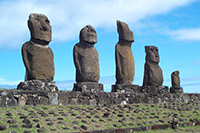Feb 18 2009
Easter Island (Rapa Nui) has gained recognition in recent years thanks to a best-selling book that used it as a model for societal collapse from bad environmental practices - ringing alarm bells for those concerned about the health of the planet today. But that’s not the whole story, says Dr. Chris Stevenson, an archaeologist who has studied the island - famous for its massive stone statues - with a Rapa Nui scientist, Sonia Haoa, and Earthwatch volunteers for nearly 20 years.
 The famous stone sculptures on Easter Island where Dr. Stevenson and Rapanui scientist Sonia Haoa have worked with Earthwatch volunteers for the last 20 years to uncover new twists in the story of Easter Island. Charles H. Whitfield
The famous stone sculptures on Easter Island where Dr. Stevenson and Rapanui scientist Sonia Haoa have worked with Earthwatch volunteers for the last 20 years to uncover new twists in the story of Easter Island. Charles H. Whitfield
Stevenson will share this punch-line on Feb. 23rd: yes, the ancient Rapanui people did abuse their environment, but they were also developing sustainable practices—innovating, experimenting, trying to adapt to a risky environment—and they would still be here in traditional form if it weren’t for the diseases introduced by European settlers in the 1800s.
“Societies don’t just go into a tailspin and self-destruct,” says Stevenson, an archaeologist at the Virginia Department of Historic Resources. “They can and do adapt, and they emerge in new ways. The key is to put more back into the system than is taken out.”
While evidence suggests the Rapa Nui people cut down 6,000,000 trees in 300 years, for example, they were also developing new technological and agricultural practices along the way—such as fertilization techniques to restore the health of the soil and rock gardens to protect the plants. As a result, every rock on Easter Island has probably been moved three or four times, Stevenson said.
“The story that Chris’s research team is piecing together on Easter Island with the help of Earthwatch volunteers—rock by rock, sample by sample—is one that offers us hope in the human spirit of innovation, and the power of people to change. What a timely lesson,” said Ed Wilson, President and CEO of Earthwatch.
Other archaeological evidence indicates that the Rapanui people radically changed their societal structure from one dominated by chiefs to one that was much more egalitarian in nature, too, which effectively leveled out their consumption patterns.
“That was the big adjustment that gets the population back to being more or less sustainable,” Stevenson says. “It was like telling today’s corporate head that the company can’t afford the million-dollar remodel of his office,” Stevenson says. “But it didn’t matter because BANG, the Europeans arrive with their dirty diseases”: the final nail in the coffin, he said.
Event details: February 23rd at the Lenox Hotel in Back Bay, Boston, 5:30pm reception, 7:00pm lecture. For more event information visit www.earthwatch.org/AIA2009